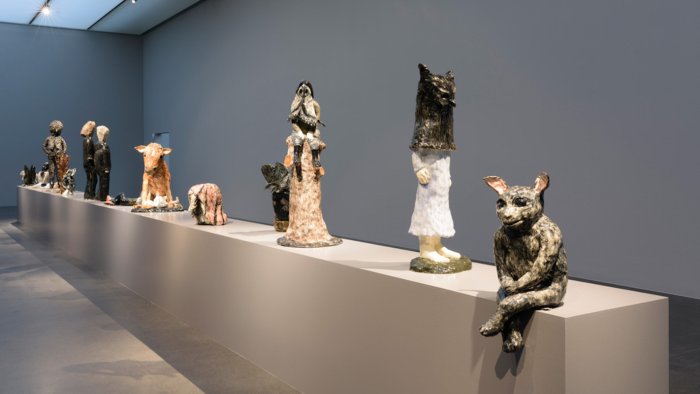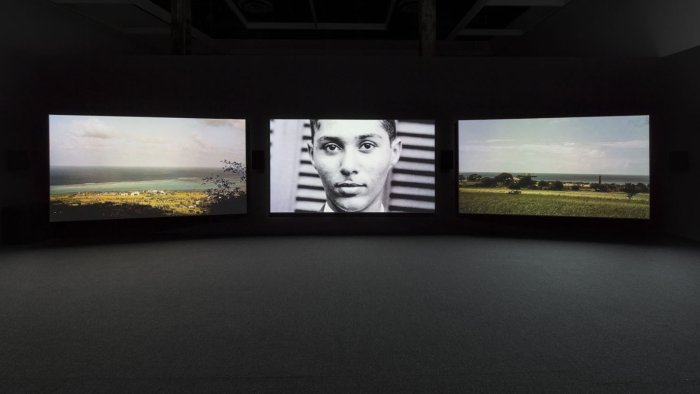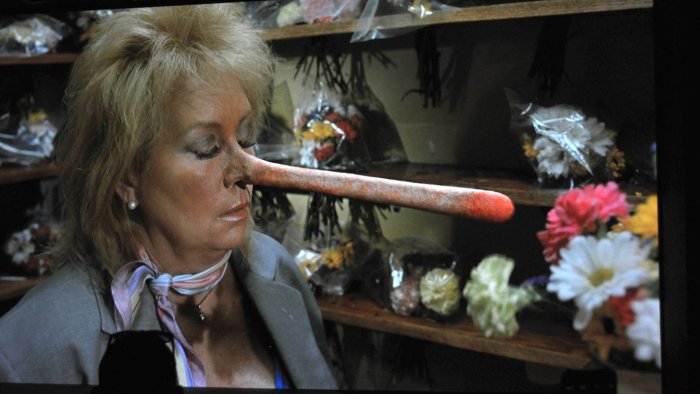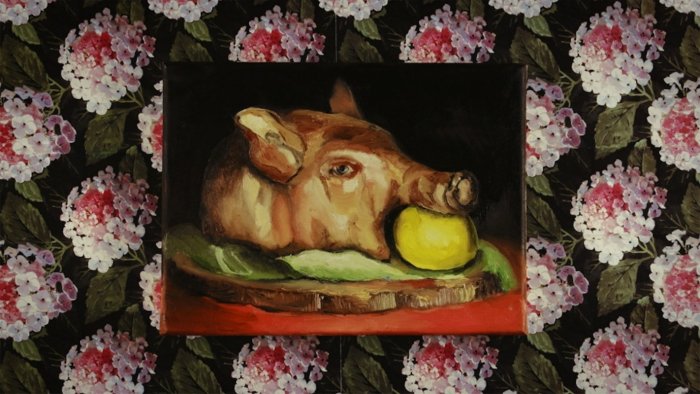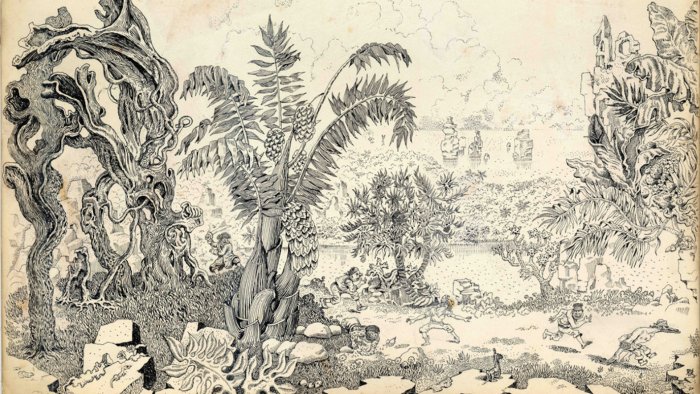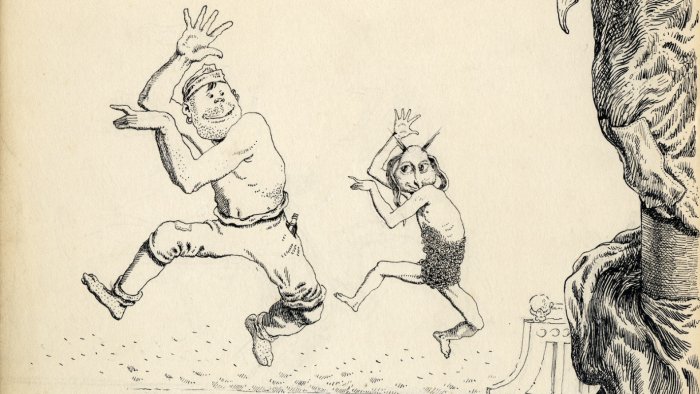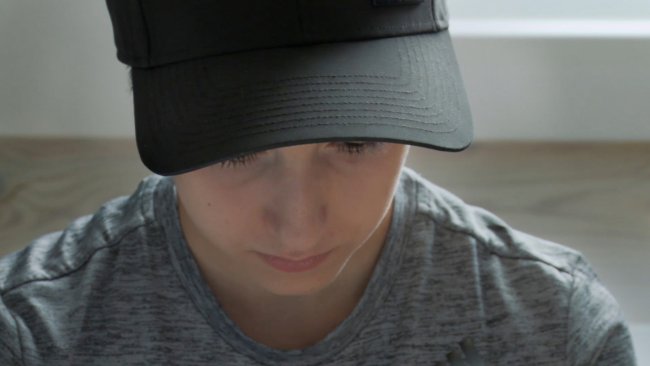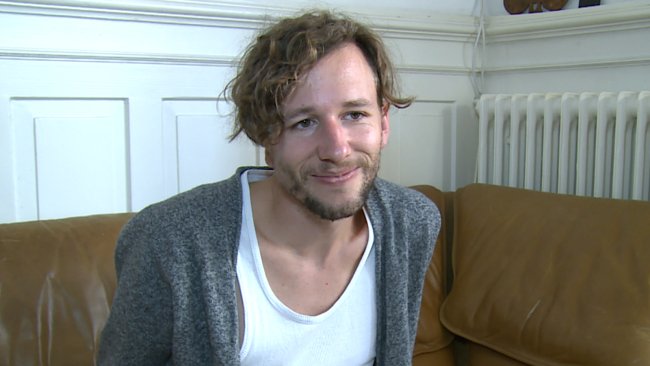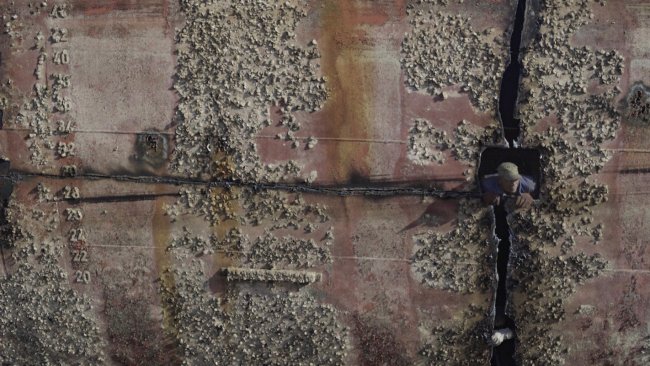Yellow Creature - Aspekte der Transformation
[…] With these half-animal/half-human figures, there is nothing to recognize necessarily, but there is also nothing completely new: we see hybrid figures that may be the result of a transformation, which pushes us to transform the way that we view the figures.
[…] We notice how putting Mervyn Peake’s illustration in a frame (that of the museum itself and the concrete frame through which the illustrations are displayed), promoting them to the status of artwork, has meant the breaking of standard frames that can block the artwork under the constraints of a specific medium.
[…] The principle of Arcimboldo’s macro/microcosmic illusionist paintings plays the central role for a transmedia aesthetic, where many references – from Wolf to Courbet to Zünd – are melted into an ironic play and where they can create an indefinable filmic object that is not meant to say one thing in particular or to make bold declarations, but to interrogate and multiply.
Text: Giuseppe Di Salvatore
Captain Slaughterboard and his crew of pirates discover an island with strange creatures that are all pink but one, which is yellow. The Captain captures and brings the yellow creature on board; but his predatory attitude will leave room for admiration, respect and friendship in the illustrations by Mervyn Peake, Captain Slaughterboard Drops Anchor (1939). In this unique tale, Peake imagines the conversion of a cruel pirate, who decides to give up his “job” of being a pirate and settle down in the lush island with his friend, the yellow creature. An anti-colonialist tale – we could say –, in which the Other triumphs in its hybrid identity.
The curator Fanny Fetzer discovered Peake’s book in 2011 and started to formulate an exhibition that could bring together contemporary works around the theme of transformation, the hybrid, transgender identities, between woman and man, human and animal, living and mineral. Now, at the Kunstmuseum of Lucerne, Fetzer proposes an incredibly coherent and intriguing path that constantly challenges our habit of thinking about identities in a rigid way. The exhibition Yellow Creature – Aspects of Transformation, which meaningfully hints at the legendary 1974 presentation in the Kunstmuseum Luzern Transformer – Aspekte der Travestie, invites us to continue the adventures of Captain Slaughterboard and the yellow creature (whose illustrations are displayed as artwork in the museum) in the context of contemporary art. For us, this amounts to an exercise that can exemplify what is called “border epistemology”, i.e. a theory of knowledge that highlights new territories that our cognition can cope with beyond the classical framework of established beliefs and immediately recognizable categories of identification.
At the beginning of the path in the Kunstmuseum, Klara Kristalova’s sculptures act as a sort of aesthetic announcement that gives us an indication as to how we should see the works in the exhibition. With these half-animal/half-human figures, there is nothing to recognize necessarily, but there is also nothing completely new: we see hybrid figures that may be the result of a transformation, which pushes us to transform the way that we view the figures. This is, in a way, the “rule of the game” of the exhibition Yellow Creature; the key for us to slide into the adventures of a contemporary yellow creature.
The works of Sabian Baumann and the group RELAX are particularly interesting because they introduce the development of the exhibition’s theme on a formal level: the artistic language is also a “hybrid” insofar as different media are used to elaborate one aesthetic discourse – illustration and sculpture for Baumann, sound installation and design objects for RELAX. If the film medium plays a central role in Yellow Creature, it is always considered as part of an installation where the film is brought into dialogue with paintings (Klodin Erb), objects (Mika Rottenberg), and with specific vessels for its reception: the black box (John Akomfrah), the television (Isabella Rossellini) or a polymorphic science-fiction theatre (Neïl Beloufa). Lia García’s performance at the opening of the exhibition even pushed the public to directly participate in the “hybridity” of Yellow Creature, as he/she performed as a mermaid unable to walk, who asks people in front of the Kunstmuseum to physically carry her/him into a swimming pool within the exhibition space. We notice how putting Mervyn Peake’s illustration in a frame (that of the museum itself and the concrete frame through which the illustrations are displayed), promoting them to the status of artwork, has meant the breaking of standard frames that can block the artwork under the constraints of a specific medium.
Thanks to the “yellowish” spirit that we are now sensitive to, we discover how John Akomfrah’s work on Stuart Hall, The Unfinished Conversations (2012), the neither white nor black critic of segregation and discrimination, points to a splendid coincidence between the form of perception and the political content. The 3-channel projection obliges the visitor to give up on trying to find a linear and univocal perception, and to accept that there is not just one statement, visual or spoken, but a multiplicity of discourses where the individual and the collective, the current and the historical, the content and the context are intimately intertwined. With a mixture of humour and a serious utopic touch, Neïl Beloufa’s video, Kempinsky (2016), imagines an African kingdom where humans, animals and minerals are melted together and the telepathic power of thought can overcome any limitations. This improbable scenario is declared through an explicitly fictitious mise-en-scène that carries with it the fragility of utopian ideologies (see Filmexplorer’s article on Neïl Beloufa and his recent movie Occidental). The fictitious and symbolic layers are used by Mika Rottenberg’s complex film, NoNoseKnows (2015), in which the absurd connection between Chinese pearl production, a woman sniffing flowers and sneezing dishes, and giant bubbles floating and exploding in aseptic office spaces, culminates into nothing but a criticism of the exploitation system of capitalism. Or, better, we should speak of bio-capitalism, where oysters and “human resources” are exploited to the benefit of the consumption of perfumes and pearls – the pearls being physically exhibited near the projection of the film as if they were ready to be sold to the visitors.
These politically-loaded discourses on hybridity and transformation, themselves also being hybrids and transformational, find a fantastic sublimation with Klodin Erb’s The Sweet Lemon Ballad (2016), a stop-motion film where another yellow creature, a lemon, has many adventures through paintings, videos, scale model landscapes and photos. The principle of Arcimboldo’s macro/microcosmic illusionist paintings plays the central role for a transmedia aesthetic, where many references – from Wolf to Courbet to Zünd – are melted into an ironic play and where they can create an indefinable filmic object that is not meant to say one thing in particular or to make bold declarations, but to interrogate and multiply. Yellow Creature is, again, a path of adventure insofar as the visit to the Kunstmuseum becomes a maze of stories, all of them attracted by the fascination of the indefinable, the hybrid, the transformational. It is the force of attraction of Marvyn Peake’s Yellow Creature, which has seduced Captain Slaughterhood, Fanny Fetzer and all of us. That is why there is a great justness in proposing, as catalogue, Peake’s book itself, Captain Slaughterboard Drops Anchor. He drops anchor, and we join him in doing so, on the unstable territory of the fantastic island of hybrid creatures, thus founding a new form of humanism. It is so nice to think of this anchor being dropped in Lucerne, in the heart of Switzerland…
Info
Yellow Creature – Aspekte der Transformation | Exhibition | Curator: Fanny Fetzer | Kunstmuseum Luzern | 28/10/2017-7/1/2018
First published: November 14, 2017
